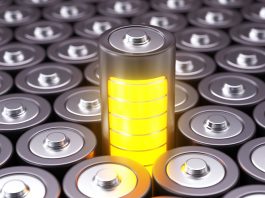EBA250 is calling for an upgrade to Europe’s battery value chain ambitions and has outlined a plan to deliver on them. Thore Sekkenes, EBA250 Programme Director at EIT InnoEnergy, explains more.
The European Battery Alliance (EBA) has been recognised as a blueprint for European industrial strategy. Now, EBA250, the industrial development programme of the EBA, is calling for the advancement of the European battery value chain and has put forward a plan to action this.
The European battery market is booming. In the case of electric vehicles (EVs) alone, 2.3 million were sold in Europe last year, marking a record-high market share of 21%. This growth rate is indicative of the entire battery value chain in the EU, and is in no small part due to the role of the EBA.
Launched in 2017 under the auspices of European Commission Vice President Maroš Šefcˇovicˇ and driven by EIT InnoEnergy, the EBA’s mission is to create a competitive and sustainable battery cell manufacturing value chain in Europe. Our achievements to date speak for themselves. However, through the supply chain disruptions that were experienced during the COVID-19 pandemic and more recently the war in Ukraine, the need for resilient, industrial value chains for the EU’s economic growth, decarbonisation, and strategic autonomy has become ever more pressing.
Whilst we have made significant progress, gaps remain for the full deployment of a resilient end-to-end battery industry. Addressing these will further support the EU’s decarbonisation and provide even more opportunities within the industry.

Five years of the European Battery Alliance
The success of the EBA since 2017 is considerable, most notably in the battery cells and application segments. In total, more than 180 industrial battery projects are being developed in the EU, with 47 in the battery cells segment. Largely thanks to the EBA’s work, the EU is set to meet 69% and 89% of its increasing demand for batteries by 2025 and 2030 respectively, and will be capable of producing batteries for up to 11 million cars per year.
The battery market has also attracted significant funding. To bolster its development, two multi-billion Euro Important Projects of Common European Interest (IPCEIs) have been initiated. Under the Horizon Europe programme, €160m was allocated to battery research in 2021 and €925m was earmarked in the EU budget up to 2027.
Although it is a good problem to have, the EBA is now ahead of its plan for 2025 that we set in 2017. Back then, we predicted €250bn of new annual GDP and 400 GWh of cell manufacturing capacity committed by 2025. Already by 2021, the total level of investment along the battery value chain amounted to €127bn. An additional investment of €382bn is expected to create a self-sufficient battery industry by 2030. The resulting aim is to have Europe capable of supporting 1,000 GWh of demand across mobility, energy storage systems (ESS), last mile, and other sectors by that time.
It is through these achievements that the EBA has established itself as the model of industrial strategy in Europe, being replicated in other countries and sectors. The work has also driven a change of mindset in Europe and fostered further public-private collaboration.

Bridging the gaps for a resilient end-to-end battery industry
Identifying and addressing the gaps is now needed to support the autonomy and continuous growth of the EU battery value chain and, in turn, decarbonisation. As part of its call to raise ambitions for Europe’s battery industry, the EBA250 recommends a set of priority actions to tackle the gaps found in both the upstream and downstream segments of the battery industry as well as much-needed training of the workforce.
Mining of domestic raw materials, processing and refining, and production of active battery-grade materials remain an issue. Downstream, recycling of end-of-life (EOL) or scrap from production facilities to be introduced as high-quality recycled metals back into the EU supply chain also needs to be addressed.
From a regulatory perspective, a rapid adoption and implementation of EU battery regulation, including the upcoming Battery Passport, will set the standard for sustainable, traceable, and circular batteries in Europe, competitively positioning European battery companies. Stringent and ambitious provisions need to be made here, with special attention on the battery carbon footprint, including sourcing of raw materials, recycling, and the thresholds of recycled material in batteries sold in the EU.
Likewise, a swift adoption of relevant legislative provisions in the European Commission’s ‘Fit for 55’ package will boost the demand for batteries to both continue decarbonising the transport system and accelerate towards a 100% renewable energy system. This includes measures supporting battery-based light and last mile mobility, the roll-out of charging infrastructure, emissions performance standards for cars and vans, facilitation of system integration, and stationary storage at grid level and behind the metre.
On the investment side, support is required to de-risk investments in raw and processed battery materials. This can be achieved through the implementation of an upgraded toolbox including a set of measures such as adapted permitting processes to reduce time and risks, introducing parallel rather than sequential processes, and harmonised rules for public consultation and environmental impact assessments.
Enhanced support for private investments is also needed. Clarifying the status of mining and processing in the EU sustainable finance taxonomy and qualifying all battery-related activities as Do No Significant Harm (DNSH) would be a big step. Additionally, strong involvement of EU and national public investors coupled with upgraded access to public grants to reduce the cost of capital in the early phases would boost private investment.
Finally, the accelerated growth of the battery value chain brings with it a growing need for a skilled workforce in all functions and at all levels. To meet the needs of the industrial projects already in the pipeline, an estimated 800,000 workers will need to be trained or upskilled by 2025. In order to bridge this skills gap, we propose earmarking 2% of the European Social Fund budget to finance training programmes related to batteries in the next three years and accelerating the implementation of the EBA Academy, our coordinated, pan-European effort to upskill and reskill key workers across the continent.
Updating the European Strategic Action Plan on Batteries for 2030
Given the accelerated progress to date, we consider it necessary to update the 2018 European Strategic Action Plan on Batteries in collaboration with the European Commission to achieve equally ambitious objectives for 2030.
In addition to the EU supporting 1,000 GWh of annual demand, the update should also reflect the expected annual added value being created in Europe to be around €625bn by 2030. For 2030, we propose targets of 100% domestic recycling coverage in the EU, 90% domestic cell manufacturing covering EU needs, 60% of domestic raw materials being processed in the EU, and sourcing 40% of active materials used in EU manufacturing.
Recommended actions within the updated plan also serve many strategic objectives, chief among them ensuring the EU’s resilience and strategic autonomy across the battery value chain. In addition, we will continue to accelerate demand for sustainable batteries produced in Europe, while accelerating regulation and permitting, and maintaining Europe’s technology sovereignty through continued access to finance. Lastly, building strategic alliances with non-EU stakeholders and strengthening external partnerships will enhance the resilience and competitiveness of the EU battery industry.
Batteries at the heart of EU decarbonisation
In order for the EU to reach its energy and climate goals, batteries and the further development of a viable European ecosystem are crucial. The EBA is delivering on its purpose of creating a competitive and sustainable battery cell manufacturing value chain in Europe, ensuring that all Europeans benefit from safer traffic, cleaner vehicles, and more sustainable technological solutions. With the adoption of the EBA’s updated strategic action plan and making progress on more immediate action points, we can accelerate the transition to clean energy in Europe while continuing to build a strong, competitive battery value chain.

Thore Sekkenes
EBA250 Programme Director
EIT InnoEnergy
https://www.eba250.com/
https://www.linkedin.com/in/thore-sekkenes
Please note, this article will also appear in the tenth edition of our quarterly publication.









